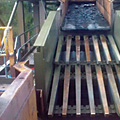A BRIEF DIVE INTO MAGNETIC SEPARATION
January 22, 2015
Before spinning out cleverly constructed sentences that determine the functions of magnetic separation, let’s take look at tramp metal. This colourful label refers to the particles and fragments of metallic ore that are extracted from the earth alongside the aggregate that is under the management of a screening cycle. The metal, typically iron, is an unavoidable component found in slurries, liquids, and large particulate matter hewn out of the rough face of a mine, and clever techniques must be incorporated into the screening process to snag this ferrous contaminant.
Magnetic separation is one solution to the ferrous obstacle, the integration of cleverly manufactured assemblies that fit into the flow of matter as it trundles up to the exit of the mine or quarry. Taking a look at just a sample of these magnetic assemblies, the equipment is designed to be retrofitted into an already running process.
Types of magnetic assemblies.
- Grate and tube configuration
- Suspended unit
- Separation roll magnet
- Drum magnet assembly
These are a few of the premium forms of magnetic separation available to industry. The grate and tube form-factor is particularly suitable for free-flowing matter, aggregates that flow over the grate and separate into fine to medium-size ferrous lumps as retrofitted on vertical chutes, hoppers, and other screening setups. The benefits of the suspended unit come from a free-floating configuration as supported above the flow. Maintenance is simpler here as no contact with the actual flow is involved.
Skipping back to the conveyor belt trains that deliver loose matter to the surface of a mine, the separation roll variant is fitted as part of the conveyance mechanism. The roll catches ferrous contaminants and traps the matter on the belt so that it can be dumped in a provided bin. Finally, on visualizing the drum magnet and its streamlined housing, this configuration is ideal for high flows of fine matter, the separation of iron filings from coal and sugarcane, pharmaceutical products and grain.
The industrial ease in which these magnets are engineered comes from the electrical design of ceramic cores and copper windings. Terms such as “axial magnetic circuit” and “radial pole design of the magnetic head” are standard terms in the engineering lexicon here, but there’s one commonality shared by each one, the isolation of iron. What about other metals? The multitude of ores found on the periodic table of metallic elements. This is where Eddy-current Separation comes to the rescue, a technique where magnetic fields are manipulated to remove non-ferrous metals.
Selecting and positioning a magnetic separation solution and its associated electrical cables, power supply, and retrofitted components, is key in ensuring a client receives a metal-free aggregate.
Screening Technology Pty Ltd T/AS Hawk Machinery
Address: 7 Lantana St Blackburn North Vic 3130
Contact Person: Bohdan Blaszczyk
Phone: +61 3 9877 7777
Fax: +61 3 9877 8177
Mobile: 0411 099 989
Email: info@hawkmachinery.com.au
Optimized by NetwizardSEO.com.au
Optimized by: Netwizard SEO


